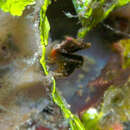Diagnostic Description
provided by Fishbase
This species is distinguished from its congeners by the following set of characters: 4 subdorsal rings; 2 pairs of bilaterally wing-like protrusions formed by a pair of large truncate spines projecting laterad on both first and second superior trunk ridges; flat laterodorsal surface on the third and fourth trunk rings; 28 tail rings 28; 14 dorsal-fin rays; 10 pectoral-fin rays (Ref. 118476).
Life Cycle
provided by Fishbase
Male carries the eggs in a brood pouch (Ref. 205).
Morphology
provided by Fishbase
Dorsal soft rays (total): 12
Biology
provided by Fishbase
Hippocampus pontohi has been observed on the coralline algae Halimeda, as well as on the hydroid Aglaephenia cupressina (Müller and Severns, pers. comm.). Severns noted it particularly in areas where Halimeda is growing on reef walls. It has been recorded at a number of areas in Indonesia (Bunaken, Cape Sri, Sorong, Wakatobi, Lembeh Straits), at depths of between 11-25 m particularly on vertical walls or in rock fissures on current-swept walls where it will tend to occur on the side of the fissure that faces away from the current, but in all cases where there is some upward current (Müller, pers. comm.) and has been seen swimming over a fungiid coral (Hardt, pers. comm.). Hippocampus pontohi is commonly found in pairs and, like H. denise, is relatively active in the morning and late afternoon when it is not in direct sunlight (Müller, pers. comm.). Two of the specimens examined were pregnant and each contained approximately 11 embryos (Ref. 79848).
分布
provided by The Fish Database of Taiwan
首次紀錄於印尼地區。臺灣潛客Jolly
Huang於2010/8/5首次記錄於綠島。
分布
provided by The Fish Database of Taiwan
2007/7/5由潛客小閔首次紀錄於綠島。
利用
provided by The Fish Database of Taiwan
目前對於其生態尚不清楚,在野外可提供潛水人員休閒及觀察,可促進特定地區之潛水活動。目前無人工飼養成功之案例,因此不建議自野外採集。
利用
provided by The Fish Database of Taiwan
在自然界可提供潛水者休閒及觀察,可成為特定地區發展潛水活動的誘因。目前無人為養殖成功案例,建議不要從野外採集。
描述
provided by The Fish Database of Taiwan
極小型海馬,體高僅1.4公分,體長僅1.7公分。體環12,尾環26-28,背鰭14鰭條,胸鰭9-10鰭條。臀鰭極小或無;吻長中等,不具前方彭大部位;下腹部體環較不硬化;雄魚幼兒囊位於肛門前;頭冠略尖且上揚;鰓孔幾乎完全癒合;體表及尾部具有排列鬆散的結節;第五結體環後部具有增大的背脊,上方具有分叉的細絲;體色白,粉紅或淡黃色,軀幹部位偶具有紅色線條;尾部具有紅色條紋。以潛客Hence
Pontoh為名。過去將小閔豆丁誤認為本種,實則為賽氏之誤鑑。
描述
provided by The Fish Database of Taiwan
極小型海馬,成魚體高13
mm。體環12,尾環27,背鰭鰭條14,胸鰭鰭條10。軀幹前方與下方體環退化不明顯;臀鰭小或無;吻中長,前方無澎大部位;頭冠明顯上揚;頸部後方具單一鰓孔;體表具有少數結節以及佈滿細小之白疣;背部於第1-4體環具有一紅色大斑;尾部白,具有2-4棕色環斑。以潛水者Mike
Severns命名。過去稱為小閔豆丁的彭氏海馬實為本種之誤鑑。
棲地
provided by The Fish Database of Taiwan
棲息在珊瑚藻(/Halimeda/ sp.)或水螅(/Aglaephenia
cupressina/)上,通常成對在一起。可能攝食浮游性動物。
棲地
provided by The Fish Database of Taiwan
國外紀錄本種與苔蘚蟲(/Catenicella/ sp.)、水螅蟲(/Lytocarpus
phoenicea, Antennellopsis integerrima, Halicordyle
disticha/)、柳珊瑚(/Muricella/)和疑似小月柳珊瑚(/Menella/
sp.)共生。在綠島曾被觀察在礁壁上與藻類及水螅共生。
Hippocampus pontohi
provided by wikipedia EN
Hippocampus pontohi, also known as Pontoh's pygmy seahorse or the weedy pygmy seahorse, is a seahorse of the family Syngnathidae native to the central Indo-pacific. Named after Hence Pontoh, the Indonesian dive guide from Bunaken (Manado) who first brought these pygmy seahorses to attention.
Description
The weedy pygmy seahorse is a small fish which can reach a maximum length of approximately 1.7 cm, which makes it one of the smallest representatives of the seahorses.[4] The body is small and slender with a prehensile tail. The head is relatively large, it represents about 25% of the size of the body.[4] The eyes are prominent. It has a moderately long snout and this later does not have any bulbous tip. The coronet rises rearwardly creating a kind of angle when the animal's profile is observed. The trunk and tail may also have some small bulbs. The coronet and the widest part of the back can have some red distinctive branching filaments. The body background color is whitish with a yellow to pinkish color on the head and backside of its body. Thin red lines may also extend from the starting point of the cutaneous filaments from its back. The tail has also some red bands.
Distribution and habitat
The Pontoh's pygmy seahorse has been recorded from central Indo-Pacific area in eastern Indonesia and Papua New Guinea.[4]
This pygmy seahorse likes reef wall exposed to current and rich in Halimeda plants or hydroids Aglaophenia cupressina between 11 and 25 meters depth.[4]
Biology
The weedy pygmy seahorse has a carnivorous diet and feeds on small crustaceans and other planktonic organisms.[4] The species is ovoviviparous, and it is the male who broods the eggs in its ventral brood pouch. The latter includes villi rich in capillaries that surround each fertilized egg creating a sort of placenta supplying the embryos. When fully grown, pups are expelled from the pocket and become autonomous.[4]
Conservation status
This species population may be vulnerable to the loss of meadows of Halimedadue to the acidification of oceans, however, it can use other habitats and is listed as Least Concern by the IUCN.[1]
Internationally, it is also listed in Appendix II of the Convention on International Trade in Endangered Species of Wild Fauna and Flora (CITES) this means that it is on the list of species not necessarily threatened with extinction, but in which trade must be controlled in order to avoid utilization incompatible with their survival.
Naming
The specific name honours Hence Pontoh, an Indonesian dive guide who brought these small seahorses to the attention of its describers.[4]
References

- license
- cc-by-sa-3.0
- copyright
- Wikipedia authors and editors
Hippocampus pontohi: Brief Summary
provided by wikipedia EN
Hippocampus pontohi, also known as Pontoh's pygmy seahorse or the weedy pygmy seahorse, is a seahorse of the family Syngnathidae native to the central Indo-pacific. Named after Hence Pontoh, the Indonesian dive guide from Bunaken (Manado) who first brought these pygmy seahorses to attention.
- license
- cc-by-sa-3.0
- copyright
- Wikipedia authors and editors

